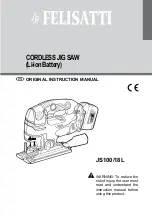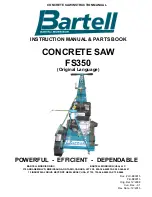
11
SAFETY GUIDELINES
10
SAFETY GUIDELINES
•
Use a separate electrical circuit for your tools. This circuit must consist of not less
than #12 wire with a 20 A time-delayed fuse or a #14 wire with a 15 A time-delayed
fuse. Before connecting the motor to the power line, make sure the switch is in the
Off position and the electric current is rated the same as the current stamped on the
motor nameplate. Running at a lower voltage will damage the motor.
Recommended size for extension cords
CAUTION!
• In all cases, verify that the outlet in question is properly
grounded. if you are not sure, have a licensed electrician
check the outlet.
WARNING!
• Use the proper extension cord. Make sure to use an
extension cord that is heavy enough to carry the current
required by the tool. An undersized cord will cause a drop in
line voltage, resulting in loss of power and overheating of
the tool.
• Use the extension cord only for intended purpose. Do not
pull the extension cord to remove it from the power socket.
• This tool must be grounded while in use in order to protect
the operator from electric shock.
ELECTRICAL SAFETY
GUIDELINES FOR USING EXTENSION CORDS:
In the event of a malfunction or breakdown, grounding provides a path of least resistance
for electric current to reduce the risk of electric shock. This tool is equipped with an
electric cord having an equipment-grounding conductor and a grounding plug. The plug
must be plugged into a matching outlet that is properly installed and grounded in
accordance with all local codes and ordinances.
Do not modify the plug provided. If it will not fit the outlet, have the proper outlet
installed by a qualified electrician.
Improper connection of the equipment-grounding
conductor can result in a risk of electric shock. The
conductor with a green outer surface, with or
without yellow stripes, is the equipment-grounding
conductor. If repair or replacement of the electric
cord or plug is necessary, do not connect the
equipment-grounding conductor to a live terminal.
Check with a qualified electrician or service
technician if the grounding instructions are not
completely understood, or if in doubt as to whether
the tool is properly grounded. Use only three wire
extension cords that have three prong grounding plugs and three pole receptacles that
accept the tool's plug, as shown in Fig. 1. Repair or replace a damaged or worn cord
immediately.
GROUNDING INSTRUCTIONS:
•
Make sure the extension cord is in good condition. When using an extension cord, be
sure to use one that is heavy enough to carry the current that your product will draw.
An undersized cord will cause a drop in line voltage, which will result in loss of power
and overheating. The table on the next page shows the correct size to be used
according to cord length and nameplate ampere rating. When in doubt, use the next
heavier gauge. The smaller the gauge number, the heavier the cord.
•
Make sure your extension cord is properly wired and in good condition. Always
replace a damaged extension cord, or have it repaired by a qualified person before
using it. Protect your extension cords from sharp objects, excessive heat, and damp or
wet areas.
AMPERAGE RATING OF THE TOOL
(120 V CIRCUIT ONLY)
MORE THAN
0
6
10
12
NOT MORE THAN
6
10
12
16
25' (7.6 m)
18
18
16
14
50' (15.2 m)
16
16
16
12
100' (30.5 m)
16
14
14
Not recommended
150' (45.7 m)
14
12
12
TOTAL LENGTH OF THE EXTENSION CORD
MINIMUM GAUGE FOR THE EXTENSION CORD (AWG)
NOTE:
Recycle unwanted materials rather than disposing of them as
waste. Sort the tool and its components in specific categories and
take to the local recycling centre or dispose of them in an
environmentally safe way.
Fig. 1
Three-prong plug
Grounding prong
Properly grounded
outlet
model no. 055-6706-6 | contact us 1-800-689-9928
model no. 055-6706-6 | contact us 1-888-670-6682
Содержание 055-6706-6
Страница 1: ......






































